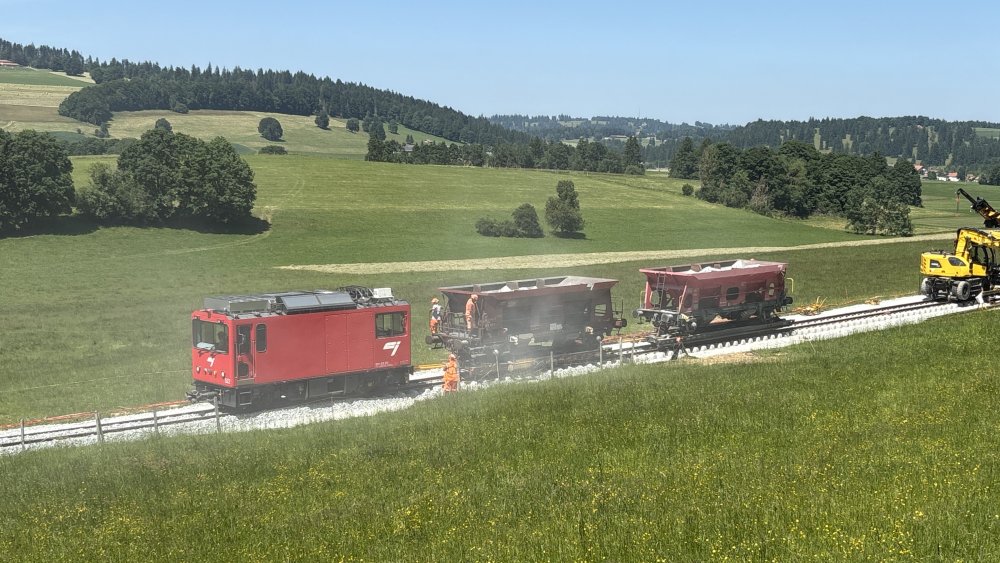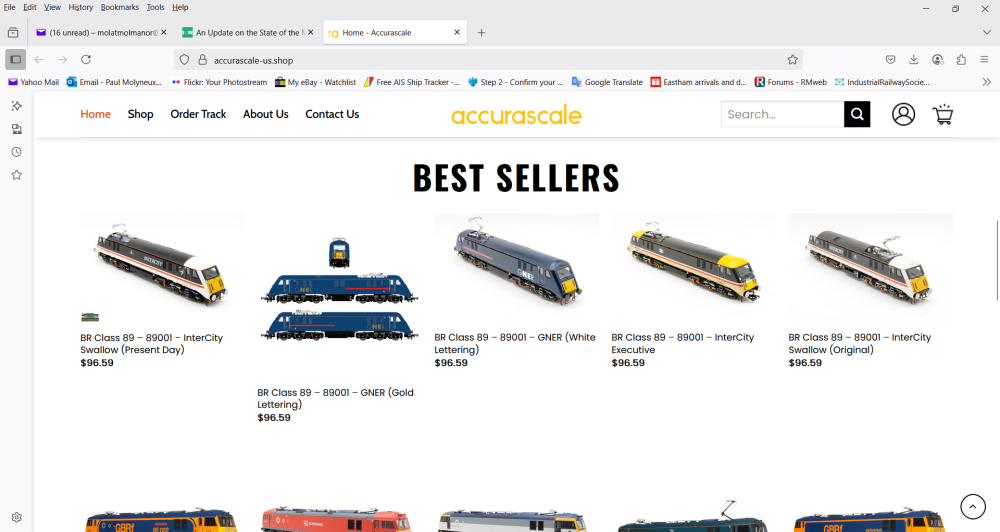
Mol_PMB
Members-
Posts
2,160 -
Joined
-
Last visited
-
Days Won
112
Content Type
Profiles
Forums
Events
Gallery
Blogs
Store
Community Map
Everything posted by Mol_PMB
-
Wonderful stuff! Having been brought up in Essex and familiar with Chappel and the Sudbury branch as well as other local branch lines like Braintree and (former) Maldon, I think you have captured the atmosphere very well. And Shannon looks superb!
-
Andreas' railway or the new West Clare Railway.
Mol_PMB replied to Andreas Weniger's topic in Irish Model Layouts
Very nice Krokodil! I am in their native country this weekend, though at the other end of it. Another rare species I’ve seen today is the transporter wagon, seen here carrying standard-gauge ballast hoppers dropping ballast on a metre-gauge line. Fun to watch. I don’t think any of the Irish narrow gauge lines used transporter wagons? They were once common in mainland Europe but rare now. -
I have bought a few tiny milling cutters with a view to making some track gauges of the flat type. I just haven’t got round to doing it yet! Unusually, I have a mill but not a lathe - this goes back many years when a friend and I bought one of each with a plan to share resources, and then ended up moving a long way away from each other! I guess I could also make jigs for milling switch blades, given time
-
Great news! The CIE vans - which variants are you offering? My preference would be one luggage van and one heating van.
-
Heritage Railways in the Republic of Ireland
Mol_PMB replied to Celtic_transport's topic in General Chat
Germany is quite strong on heritage railways, and a decade ago I would have said Austria too. There is also a great deal of interest in railway heritage in Switzerland but the operating model is different - almost all the independent metre gauge lines have a heritage operator as well as the regular one. More like lots of mini-RPSIs, but most now have operating licenses in their own right rather than relying on the host railway for drivers etc. Switzerland probably has more heritage operations per capita than the UK, but they operate less frequently. -
I’m learning Templot and selecting 21mm gauge is easy, as is setting your preferred checkrail clearances etc. Some other aspects have a bit of a learning curve but I’m getting there. Personally I don’t have printing capability. Also a lot of the standard templates are for bullhead rail whereas my preferred prototype is flat-bottom. But it’s all getting closer…
-
Heritage Railways in the Republic of Ireland
Mol_PMB replied to Celtic_transport's topic in General Chat
That is a good example of the challenge. It doesn’t just need a vast amount of money and commitment to create in the first place, it also needs an ongoing commitment from many other people to keep it going long term. -
Heritage Railways in the Republic of Ireland
Mol_PMB replied to Celtic_transport's topic in General Chat
It’s worth noting though that the ‘running costs’ of a large old building can be very high, especially if it’s past its best and you’re trying to keep the internal environment suitable for the conservation of historic artefacts (e.g. moderately stable temperature and humidity) Most museums don’t make money, even NRM York has become more of a food court than a museum in an attempt to cover its costs. To achieve an income with any hope of covering the costs you would need the museum to be open most days. A few special events per year won’t cut it. -
I’m glad someone here has picked those up. I was briefly tempted by them but they don’t really suit my plans. I now have a lot of work ahead of me to regauge and backdate 9 grey bubbles. I’m not far off finishing the batch of 7 H vans so perhaps the bubbles will be next. My imaginary Fenit Pier layout is going to need an imaginary model Vigan to handle the cement traffic!
-
Green A46: https://ebay.us/m/Tdp9Rp
-
Thank you!
-
Something to do with depot facilities? Is the train too long for the pit roads, and has to be inspected one way round to do one end, then turned to get the other end over a pit?
-
The fixing screws are modern, so it probably doesn't belong to that gate originally. Perhaps it is attempting to acquire provenance?
-
Some of the former Enterprise Mk2 coaches and a driving trailer were repurposed into 80 class trailers to replace damaged vehicles. For a while, one set comprised ex-Enterprise intermediate and driving trailers, basically types already made by IRM. All you would need is the power car and a repaint of the coaches. That wasn't a typical set though. Jonathan Allen has quite a few photos of 80s hauling parcels vans of various types (including converted AEC / MED cars and NCC brown vans), in their early days: https://www.flickr.com/photos/152343870@N07/25652512517 https://www.flickr.com/photos/152343870@N07/38515339670 https://www.flickr.com/photos/152343870@N07/52858373472 https://www.flickr.com/photos/152343870@N07/52859340950 https://www.flickr.com/photos/152343870@N07/52140511098 https://www.flickr.com/photos/152343870@N07/26651868158 I've also seen photos of 80s dragging 1 class shunters: https://www.flickr.com/photos/152343870@N07/51784934903 And here's an 80 with a short PW train: https://www.flickr.com/photos/152343870@N07/52140730349 I confess these are not in the same league as the 70s antics on freight and mixed trains: https://www.flickr.com/photos/152343870@N07/25591673517 https://www.flickr.com/photos/152343870@N07/40247664354
-
Nice work!
-
mgwr preserved railway Connemara Railway project.
Mol_PMB replied to ttc0169's topic in What's happening on the network?
I suppose it's ultimately down to what the promoters want and/or have committed to in their planning application, business plan etc. Well done to all concerned for what has been achieved so far, not just a working narrow-gauge line but saving some interesting and unique standard-gauge stock too. My gut feel is that now there's a (smallish) functioning railway with locos, carriages, track and signalling, it would be a good idea to focus resources on buildings and infrastructure. It can be a wild part of the country in bad weather, and being so isolated also means that security may be challenging. After the storm damage, repairing/restoring the existing structures to a more robust standard would be a good priority, possibly extensions/alterations to the existing factory buildings to provide more secure covered storage and/or workshop facilities. If the 5'3" is the long-term goal then at least one shed large enough for a complete 5'3" gauge vehicle would be a necessity, and such a shed would have plenty of other uses in the meantime, even if the line were to remain 3' gauge. Sheds aren't actually that expensive compared to the cost of deterioration and damage to equipment left out in the open. -
I stumbled across this webpage today, which gives details of Bulleid's prototype plywood coach, built in 1946 when he was still at the Southern Railway: https://sremg.org.uk/coach/bulleid.shtml "The design has been likened to an inverted ship's hull with the keep plate or ridge rail running along the centre of the roof like the keel of an upsode-down ship. Pre-formed sections 9ft 5ins wide made of 9/16ths in nine-ply birch were bolted to the ridge rail and underframe and resin-bonded to the saloon framework which was of similar ply construction. " This form of construction sounds like the prototype of the 'laminate' construction that he later introduced for CIE. They had the further refinement of an aluminium outer skin on the ply, of course. Someone has built a model of it, here: Bulleid’s on Display at Taunton, and also something for the sleepy film buffs… - General - Muz's modelling mastications - RMweb Just thought this might be of interest as I hadn't heard of it before. Like triangulated underframes and the bogie steam locos, it's another example of Bulleid's innovations that were initiated on the Southern but found their final development in Ireland.
- 1 reply
-
- 2
-

-

-
Interesting, many thanks for asking, and certainly makes things easier for bullhead track. Are there suppliers that will 3D-print the turnout bases from Templot geometry? I'm still getting to grips with Templot myself, but I can see the possibilities it opens up.
-
Heritage Railways in the Republic of Ireland
Mol_PMB replied to Celtic_transport's topic in General Chat
Very true! In GB there is some history of smaller locos on the main line too, such as Tyseley's 0-6-0PTs, and a 14xx 0-4-2T, even the steam railmotor, as well as several of the better-known BR standard 2-6-4Ts comparable to the NCC Jeeps. But in GB the economics and available paths definitely favour longer trains, higher speeds, and hence larger locos. In Ireland, while main-line paths remain affordable and with achievable timings, and while heritage rolling stock can remain compatible with modern infrastructure, that will be significantly more cost-effective than any 'new' preserved line. I fully agree with the posts above that we need to support existing organisations before thinking of creating new ones. -
Heritage Railways in the Republic of Ireland
Mol_PMB replied to Celtic_transport's topic in General Chat
I apologise if this comes across wrongly, from the other side of the water. I'm thinking about the general interest in various periods of history. In Britain, the golden age of the railways and industry (perhaps 1840-1940) was also a period when Britain had a lot of global power and influence. Although we now realise that our ancestors abused some of that power badly, a great deal was achieved and there's still a lot of interest in Britain about that period in history. Looking back, even the terrible loss of life and sacrifices in wartime are contrasted with the developments in technology and military power which interest so many people. The same century in Ireland was, in many places, marked by tragedies of famine, poverty, mass emigration, civil war, and other troubles. I suspect it's a period that many people would rather not remember or commemorate. That might be why... I've seen similar in China, where there is great celebration of the ancient history, and the modern culture, but the 1940's-1970s era of political upheaval, famine and tragedy is not celebrated, sometimes even taboo. -
At this rate the Diesel Day will need to be a whole weekend! More seriously, you’ve done very well indeed and I appreciate there’s a lot more to it than getting the engine started, before the loco is fit to run in service. A lot of paperwork no doubt, as well as the engineering.
-
Many thanks - that is very helpful. If you do get a chance to scan it properly that would be great, as there's some distortion in the image as posted. It shows the early type of 'Big Boy' with wooden body framing on a steel chassis, as illustrated in these links: Manufacturer's photo in the HMRS collection: From Ernie, an example late in life with sheet material over (or replacing) the planks: A more distant view from the IRRS Flickr: https://www.flickr.com/photos/irishrailwayarchive/53508884101 The book 'Great Southern & Western Railway' (Murray & McNeill) has only one small page of the rolling stock chapter describing wagons, which includes the following statement, the only one relevant to 'Big Boy' vans: 'In the early 1900s some 19ft vans were put into service of which some were 9ft wide, but the width caused trouble in getting through the doors of goods stores, and the order was not repeated'. Regarding width, Ernie's photo above indicates that the width is very similar to the adjacent vans, which are 8'1" over corner pillars, and the drawing kindly provided by @Broadstone appears to be the same width. The comment in the book may well be true, that the 9' wide vans were not repeated (and I have not found any photos of them), it would appear that several batches of 'Big Boy' vans were produced with the extra length and height but of standard width. Regarding length, there is firstly some doubt about what length is referred to - over headstocks, over body, over buffers... I have attempted to scale from photos such as this one: https://www.flickr.com/photos/irishrailwayarchive/53511622719 and I think the length over headstocks is somewhere between 19' and 19'6", but that approach is imprecise owing to lens distortion etc. Scaling off the drawing should be a bit more accurate despite the slight distortion, and appears to show about 19'8" over headstocks. Hopefully a measure of the surviving (modified) vehicle at Cultra will resolve the main dimensional questions.
-
Today I have received scans of two HMRS drawings for Irish rolling stock, which I had requested a few weeks ago. Their initial response to my enquiry was very quick, within hours, and they said it would take a few weeks to get them scanned. That occurred within the expected timeframe and now I have these two. It will take another week or two for the images to go live on the website; obviously I can't post them here as they are HMRS copyright: https://hmrs.org.uk/hmrs-32404-6-plank-10-ton-9ft-6ins-w-b-16ft-11ins-o-b.html https://hmrs.org.uk/hmrs-32405-10-ton-9ft-6ins-w-b-17ft-5ins-o-b.html They are excellent quality drawings, circa 120MB .tif files, very large and clear, well-dimensioned and detailed including wheelsets, suspension, buffer and drawgear springs etc. The lettering details are also shown. They also include copious notes and some later annotations. They come from the Metropolitan-Cammell archive and illustrate wagons built by their earlier constituent the Metropolitan Carriage & Wagon Co. Drawing 32404 (10 ton 6-plank open wagon, steel frame) covers GSWR order B7S53 of 1920, for 150 wagons numbered 10360 to 10509. They are in accordance with the IRCH drawings but the MC&W drawing has much more detail than the published IRCH drawings. [We know from other sources that the last 20 of these were ordered on behalf of the CB&SCR and became their 631B to 650B] Drawing 32405 (10 ton covered goods wagon, steel frame) covers GSWR order B7S54 of 1920, for 130 wagons numbered 15340 to 15469. Again they are in accordance with the IRCH drawings. Neither of these are 'Big Boys'. The IRCH steel-framed vans were similar in appearance but smaller than the 'Big Boys'. In due course I'll put together a thread of photos and info on the steel-framed IRCH vans, and then I'll look at tackling the 6-plank opens. Meanwhile I am continuing to research the 'Big Boys' and in the absence of a drawing I'll measure up the surviving similar van at Cultra in August.
-
It was there half an hour ago - offering class 89s at less than $100, for example. Edit: Still there now, in fact:
-
Here are a few photos of the 2-track sector plate on my O gauge shunting layout, which is built into a bookcase. The sector plate was an afterthought, hence the rough edges! But hopefully these photos show how it works; either track on the sector plate can access either track on the scenic section.
.png.c363cdf5c3fb7955cd92a55eb6dbbae0.png)






